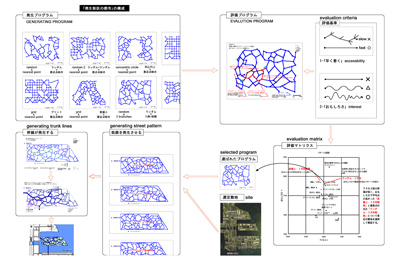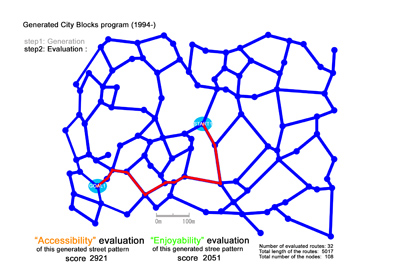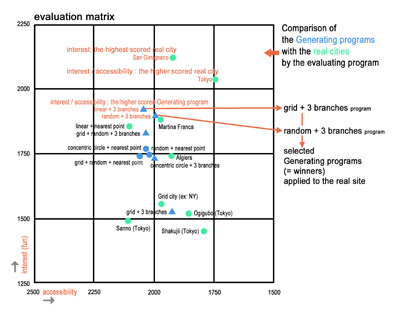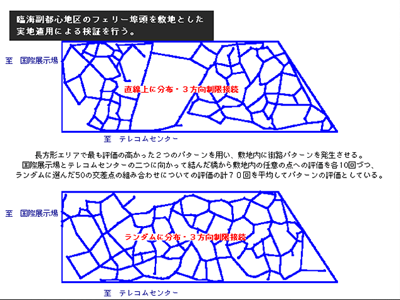Gen 2 INDUCTION DESIGN series
GENERATED CITY BLOCKS 1994





A city begins by building streets.
"Streets are major and houses are minor"-this old saying seems to be true even today.
Streets are usually made to run straight. There seems to be a principle at work that a straight street is better than otherwise, as evident in the cases in which a new road is planned for a place where there is nothing that stands in the way, like the MM 21 (Minato-Mirai 21, the pioneering urban restructure project near Yokohama Station), the Makuhari development project, and the "Frontier" city on the Tokyo Bay waterfront. Most older towns are not made up of straight streets laid out in a grid pattern.
People take particular pleasure in walking along the twisty roads of a labyrinthine town. Straight streets complemented by intricate networks of alleys running behind them give a town a sense of depth.
In planning a new town from scratch, however, a planner cannot be certain whether it is really all right to make a labyrinth of streets from the outset.
So, it is usual that streets planned for a new town to become a monotonous pattern of streets that all run straight or that curve only gently in no more than a fan shape.
But is that enough?
Why, then, do people find so much pleasure roaming about in town that is a maze of streets? That question led to this project.
What makes a street nice?
First we need a yardstick for evaluating what a street should be.
The yardstick involves both accessibility and enjoyability. In other words, a road we judge good is one that takes you to your destination quickly and that gives you pleasure in the process of getting there. Accessibility is considered mainly in terms of traffic by car and enjoyability in terms of walking.
These two criteria can be established using numerical formulas. Omitting the details here, this was achieved by assigning scores according to type of intersections and rhythms of variation in road curvature.
A program for conducting that series of evaluation activities was created.
But even when an "evaluation program" is available, it will be of little use if streets are poor from the outset.
It follows then that another program need be created that will "generate" street patterns.
The generation of streets means setting up a set of rules for connecting lines (streets).
A mere change in the rules makes a big difference in the characteristics of a resultant city block pattern.
The two programs thus created are linked together. Blocks are automatically assigned scores and listed. Existing towns are evaluated too.
Then, you actually walk around the actual towns that are ranked high or low to verify the reliability of the evaluation program.
What is important here is not whether the criteria of evaluation are valid.
What to select as criteria and how to establish them can be improved whenever necessary by incorporating the fruits of the behavioral sciences, biotechnology, and so forth.
The purpose here is not to build a grid-pattern city by force of habit or produce a labyrinthine town on a whim, but to present the potentiality of a methodology for creating a city that will not only be as natural as spontaneously generated living organisms but will also satisfy certain specifications.

